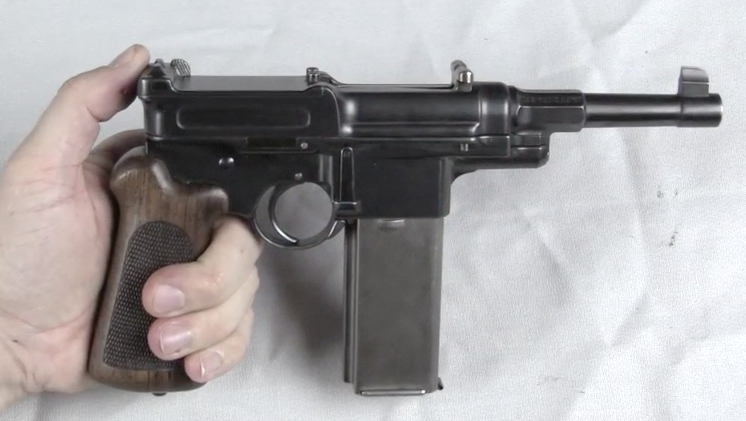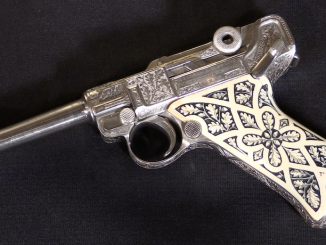With my handy new high-speed video camera, I’ve started taking some footage of interesting guns operating. First up is the Luger:
The camera will do 500 frames/sec at very high quality, and just under 18,000 frames/sec at very low quality – and there is a sliding tradeoff between the two. So my goal is to work out the best balance of speed and video quality where we can clearly see what is going on in the mechanism. The 2,000 fps clip seems to work pretty well for the Luger – rifles run a bit slower in general so they can use higher-quality video, and a few pistols (like the 1908 Schwarzlose) run faster than the Luger and need a higher frame rate to really see well. I am doing more video with the high speed camera through this week…
Updated to add a second video, of a short-barreled 1860 Army replica, also at 2000 fps:




This is why I donated I wanted to see amazing videos like this. Thanks for the great video.
Very nice. I wonder if a Vickers-Maxim HMG can safely be fired with the side panel of the receiver open? (Or even the one-pounder “pom-pom”?)
Since it’s a blow-forward, the M1908 Schwarzlose must look like it’s dismantling itself when it fires.
A Mauser M712 (1932) “Schnellfeuer” or its “inspiration”, the Astra 903 selective-fire “Broomhandle” clone, on full-auto would be interesting. You’d probably need to go to 3,000 fr/sec, or even 4,000, to catch the bolt in motion, considering their formidable cyclic rates.
The Astra Model F, with the flywheel rate-reducer in the butt, would be interesting as a comparison, as would the vz.61 Skorpion in any caliber, with its spring-operated lever rate reducer.
cheers
eon
Aha, now we are getting into need for X-ray fast camera… :-)))
Great show! How about a Webley-Fosbury, or a Dardick ejecting “trounds”?
(Hard to do either one I expect!)
Hopefully I can do a Webley-Fosbery eventually…the Dardick is going to be harder.
If the problem with the Dardick is the ammo, Dardick made an adapter that took a .38 Special round. It seems like it would not be rocket surgery to make some of these, if we can come up with the gun from somewhere. Problem with the Dardick is most of the exotic stuff is inside.
oooh, that’s nice.
I would have contributed to the fund, only I don’t have my own bank account.
Creditors… Extortionate one’s, I refuse to pay the level of interest.
I do believe I offered a Western Union contribution.
“So I’m not being tight”
Many thanks Ian and all of you who were able to donate.
I’ve wondered for a long time how much the actual grip frame of a Luger recoiled before the toggle’s knee joint hit the accelerator ramps on the frame
now I know – negligable.
The point at which the momentum of the recoiling barrel and slide is transferred to the bolt also looks to be fast enough that resistance from the firer’s hand can be ignored – and the inertia and friction of the parts alone can be used for calculating the internal dynamics.
Is there any chance of a few spots of makeup or marker pen on the hand joints and fore arm of the firer – so if anyone is particularly nerdy, they can get an idea of how the grip interacts with the firer’s hand and arm in recoil.
Once again, fantastic stuff, and many thanks for the team effort.
Very good example to begin with, since toggle knobs contact with frame ramps can only be possible with actual firing. Simply pushing the barrel against to a suitable hard object of an unloaded Luger can not demonstrate how toggle joint goes to unlock since upward breaking begins slightly before ramp and knob contact by effect of the recoil spring. Thanks Ian.
The 1860 Army firing is fascinating. I’d never realized that the cap sideflash was that large from “behind” one. I know from experimentation that the barrel/cylinder gap will scorch paper, but I suspect the cap sideflash could easily ignite a sheet of note-paper.
This alone tends to make the legendary “hip-shooting” of the percussion era more dubious. I’m inclined to believe that real-life “pistoliers” fired at full arm extension, not only to use the sights but also to avoid being singed by that sideflash. After all, the objective was to injure the target, not yourself.
cheers
eon
This is a detriment, for sure. I’m also less enthusiastic for old style percussion pistols after seeing this.
Lacking personal firing experience, I was also surprised by the lag between the cap ignition and chamber ignition. I would think that would seriously degrade accuracy, especially with the likelihood of the shooter flinching at the cap flash (though I’m not sure whether that’s a quick enough reaction to cause a problem).
Just as one of the long term trends in small arms is smaller calibers and higher velocities, another is shorter lock times. A percussion lock does seem very slow compared to a cartridge gun, but it’s “instantaneous!” if your standard of comparison is a flintlock — which is damned quick compared to a matchlock.
For quire a while after the introduction of the flintlock, the wheel-lock was still favored on high-quality sporting arms like hunting rifles. The reason was that since the wheel-lock cock is already most of the way “down” on the wheel, in the priming pan, there’s a much shorter “hammer fall”, resulting in a faster lock time.
cheers
eon
One of Colt’s early patents was on the sort of well each cap is in, protecting it from flash from the others. Likewise, he came up with a beveled chamber to reduce flash-over or chain-fire, a real problem with previous revolvers (including his prototypes).
I can see that the original Colt Paterson revolvers without the partitions between the primer nipples in the cylinder could go off like a grenade. I have Colt and Remington replicas, and I’ve never seen a flash behind the hammer before!
It’s literally over so fast your eye can’t see it. Like the beat of a hummingbird’s wing.
cheers
eon
The Colt does illustrate the “boom” well, if they had of seen that maybe the civil war wouldn’t have happened… They’d be like “fire these at each other that’s lame, we will all be lying around dead in no time” mmmkay.
A late comment after watching the Mauser C96 and all of the bouncing which its bolt and slide do.
despite the early leaf sprung lugers haveing a special catch on the toggle joint to prevent the toggle from bouncing open again, there seems to be little if any percptable bounce on that (catchless) Luger’s toggle as it goes into battery.
Ian, not sure, did I ever upload that WWII German Luger 08 manual? All in German. If not remind me how to send it, and I will.
Regards,
Bruce Jolly